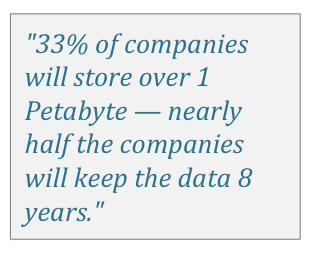One constant that defines the be all end all of problem statements when it comes to data storage is simple – the enterprise needs more room. This has been the primary focus for storage technology providers like Seagate since the inception of the server-client architecture. The advent of Cloud, Mobility, Social Media, and Big Data over the past five years is not creating a new problem, it’s just elevating the problem by orders of magnitude.
I will argue that storage capacity is only one facet of the problem. As data explodes, the need to move data around faster and faster is also placing added pressure on cost effective performance, but we’ll cover that in the next post in a series focused on end customer challenges. For now, let’s focus on capacity, and the head scratching and calculator pounding that many CIOs are experiencing. Storiant put together an awesome graphic based on a survey of 100 CIOs they conducted this year. The key takeaways reading between the lines:
- Today, 56% of companies surveyed store >500 Terabytes of data
- In 2 years, 33% will store >1 Petabyte of data – mostly unstructured data
- Nearly half (46%) will keep the data for an average of 8 years
- It will cost companies nearly $25 Million to store data for 8 years
- A vast majority (75%) of companies surveyed have 50% of their data most likely on tape
Looking at this through the lens of a hard disk drive (HDD) manufacturer, what does this mean? There are two fundamental gaps / opportunities here for HDDs:
- Storage capacity requirements will double in the next 2 years for many of the companies surveyed. The need for HDDs at least twice the size of today 4TB are a must by 2016
- Data retention capacity is only half the equation. Access to cold data or archived data needs to be faster (on HDDs), last longer (up to 10 years), and deliver lower TCO
- The old storage-server way of doing things may not deliver the economics needed in a world demanding lower cost scale-out storage solutions.
What is the solution?
- Technologies like Shingled Magnetic Recording, Helium, and HAMR need to ramp quickly in order to drive costs out of delivering storage capacity.
- New low cost/TB HDD solutions for cold storage and archive are inevitable to meet CIOs need for not only lower cost capacity, but faster access to data for analysis.
- Fresh approaches to redesigning the storage stack to be more scalable, flexible, and cost effective like platforms that leverage ethernet HDDs and APIs that talk to software.
What this infographic also says that we have not touched on is that public cloud services tend not to be the solution for many of the CIOs surveyed. Security being the main area of contention. Reading between the lines here, what this tells me is the scalable design, management, and operational efficiency that is employed and enjoyed by public cloud providers today will make their way into the traditional enterprise. That said, what many of us call “Cloud” today will simply mean “Enterprise” and vice versa.
Beyond capacity, enterprise customers are dealing with serious bottleneck issues when it comes to storage performance. SSD is an answer to this, but in many cases, it’s not the only answer. We’ll cover that in our next post.










[…] This is particularly applicable when it comes to storage technology. In fact, the data growth story is one that may not approach the level of cloud in terms of the hype scale, but it is definitely both related and guilty of being very heavy on the what, and not so much on the so what, and therefore. Infographics are known for being a great source of a lot of the stats, charts, and graphs I talked about earlier. Have you even tried dissecting an infographic to come up with the so what, and therefore implications, possibilities, and solutions for your business? I attempted this relative to Seagate in my last post titled “Storage causing CIOs to scratch their heads and pound the calculator.” […]